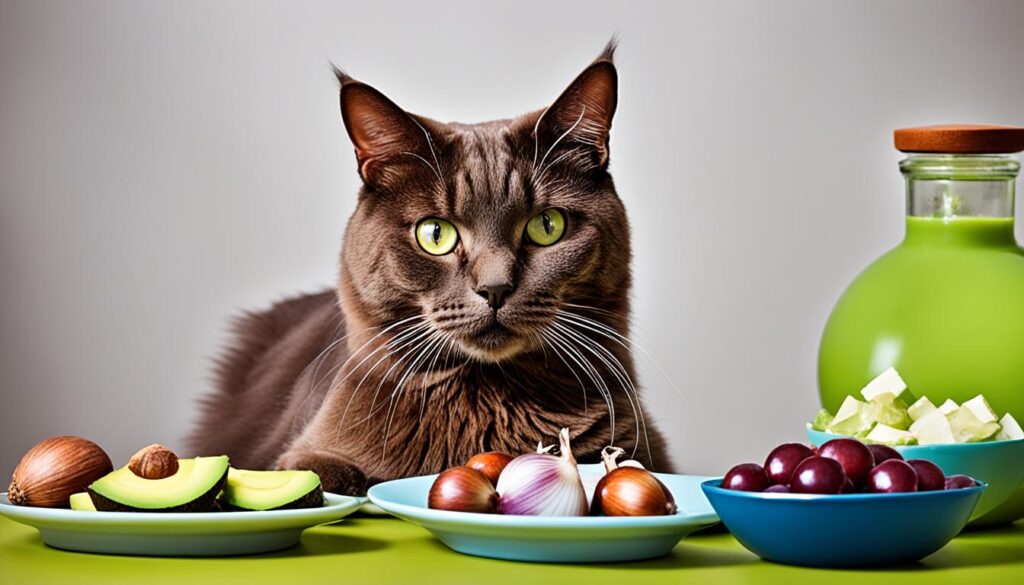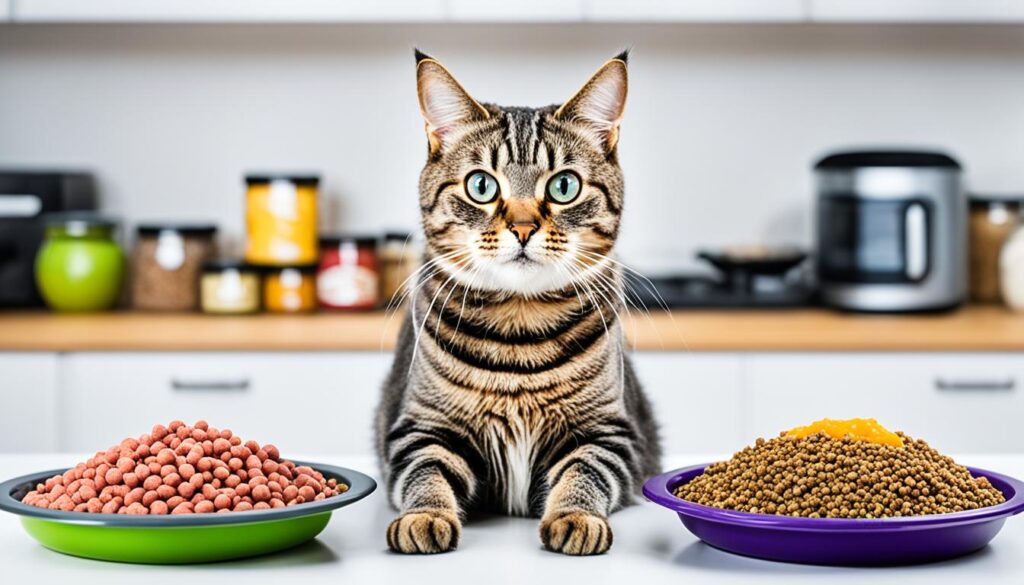Cats have their own food likes and dislikes, which can differ from one cat to another. Some cats prefer certain foods over others. Knowing what do cats like to eat helps us feed them well. This article will look into what cats prefer to eat and their dietary needs.
Cat food preferences often lean towards protein-rich meals. Cats need a diet high in meat since they are obligate carnivores. Protein is key for their health, supporting their muscles, organs, and immune system.
Cats also need essential vitamins and minerals for good health. These include vitamins A, D, E, and K, along with minerals like calcium, phosphorus, and potassium. These nutrients are vital for healthy bones, teeth, and organs.
Moisture in food is also crucial for cats. They don’t drink much water, so their food should help keep them hydrated. Wet cat food, with its high moisture, is great for keeping cats well-hydrated.
We will now look into popular cat food choices. We’ll compare wet and dry cat food and talk about the benefits of a raw food diet. We’ll also share some homemade cat food recipes and safe human foods for treats.
Knowing what cats like to eat is key for their health and happiness. By offering their favorite foods and meeting their nutritional needs, you can help your cat live a happy and healthy life.
Understanding Your Cat’s Nutritional Needs
Cats have special nutritional needs for their health and happiness. It’s key to know what these needs are and how to feed them right. We’ll look at the main parts of what your cat needs, like protein, vitamins, minerals, and water.
The Importance of Protein in a Cat’s Diet
Protein is very important for cats because they are obligate carnivores. This means they mainly need meat in their diet. Protein helps with muscle growth, repair, and overall health. It gives cats the amino acids they can’t make on their own.
To get enough protein, feed your cat high-quality meat like chicken, beef, or fish. These should be the main part of their diet for their health.
Essential Vitamins and Minerals for Feline Health
Cats also need certain vitamins and minerals for their immune system, bones, and organs. These nutrients keep your cat healthy and happy.
Important vitamins for cats include vitamin A for their eyes and immune system, vitamin D for bones and teeth, and vitamin E for fighting off free radicals. Minerals like calcium for bones, iron for blood cells, and zinc for skin and coat are also crucial.
Make sure your cat eats a balanced diet with these vitamins and minerals. Look for high-quality cat foods that have the right amounts. Reading labels helps you choose the best food for your cat.
Balancing Moisture Content for Hydration
Hydration is key for your cat’s nutrition. Cats don’t drink much water, so they get most moisture from their food. So, it’s important to make sure their diet has enough water to prevent dehydration and keep them healthy.
Wet cat food is a great way to keep your cat hydrated because it has more moisture than dry food. Or, you can give them moisture-rich treats or fresh water all day.
Talk to your vet to find out what your cat needs based on their age, breed, health, and lifestyle. They can give you advice on the best diet for your cat.
What Do Cats Like to Eat?
Cats have their own likes when it comes to food. Some cats might like a certain brand or flavor, while others prefer different textures or types of food. But, there are some foods that many cats enjoy. These include high-quality wet food, which is moist and has a meaty feel.
They also like foods with fish or poultry flavors. It’s important to make sure they get a balanced diet, though.
The Great Debate: Wet vs Dry Cat Food
Choosing cat food can be tough, with wet and dry options each having pros and cons. It’s key to know these to pick the best for your cat.
Pros and Cons of Wet Cat Food
Wet cat food, or canned cat food, is a top pick for many owners. It’s high in moisture, which helps keep cats hydrated. This is great for their urinary health and preventing dehydration.
It also has a natural texture and smell, like prey in the wild. Cats find it appealing, especially those with smell issues or dental problems. Plus, it’s easy to chew and swallow, good for kittens, older cats, and those with dental issues.
But, there are downsides. It costs more than dry food and has a shorter shelf life. You must refrigerate it and discard leftovers after a while. Some cats might prefer it, making switching to dry food hard later.
When to Choose Dry Cat Food for Your Pet
Dry cat food, or kibble, has its own benefits. It’s convenient and lasts longer. You can store it easily and leave it out for your cat all day. This is great for busy owners.
It also helps with dental health by reducing tartar and plaque. Chewing kibble can help clean your cat’s teeth.
But, dry food has less moisture than wet food. Cats don’t drink much water, so dry food alone might not keep them hydrated. Cats with dental issues might also struggle with dry kibble.
Deciding on a Mixed Diet for Optimal Health
A mixed diet of wet and dry food can be good for your cat. It gives them the best of both worlds, meeting their nutritional needs and preferences.
This mix offers the moisture and natural taste of wet food with the convenience and dental benefits of dry food. Diversifying your cat’s diet helps meet their specific needs for balanced nutrition.
Talk to your vet to find the right mix of wet and dry food for your cat. They can suggest the best diet based on your cat’s age, health, and needs. This ensures your cat stays healthy and happy.
For more info on wet and dry cat food, check out PetMD. They offer insights on nutritional needs and expert advice on choosing the best diet for your cat.
Exploring Raw Food Diets for Cats
Raw food diets are becoming popular among cat owners who want a more natural diet for their pets. This diet is based on what cats ate in the wild. It means giving them food that’s close to their natural diet.
Raw diets for cats include uncooked meat, bones, and sometimes veggies. Fans of this diet say it can boost digestion, make their skin and fur healthier, and give them more energy. But, it’s important to switch your cat to this diet carefully and safely.
Understanding the Raw Food Philosophy
The idea behind raw food diets is simple: cats do best on fresh, unprocessed food. This diet mimics what cats would eat if they hunted in the wild. It’s thought to give them the nutrients they need for good health.
These diets usually have muscle meat, organ meat, bones, and a bit of veggies. This mix is seen as a balanced way to feed cats, just like they would in the wild.
Safety Measures for Feeding Cats Raw Meat
Raw diets can be good, but they come with risks. Raw meat can carry harmful bacteria like Salmonella and E. coli. This is a big concern for cat owners.
To lower the risk, get your meat from trusted sources. Always handle it safely, store it right, and keep it clean. Clean your cat’s bowls and where you prepare food often to prevent germs.
How to Transition Your Cat to a Raw Diet
Switching your cat to raw food should be done slowly to let their body adjust. Start by adding a little raw food to their usual diet and slowly increase it over weeks.
Talking to a vet who knows about raw feeding can help a lot during this change. They can make a plan that fits your cat’s needs and check on their health as you switch.
Keep an eye on your cat’s weight, health, and how they feel as you switch diets. If you see any big changes, like losing weight or feeling tired, talk to your vet right away.
Switching your cat to a raw diet can be great, but it needs careful thought and your vet’s advice. Always think of your cat’s safety and talk to your vet before changing their diet a lot.
Homemade Cat Food Recipes and Tips
Looking to feed your cat on your own? Homemade cat food recipes might be what you need. Many cat owners like making their own food. It lets them control what goes into their pet’s meals and tailor it to their needs.
Here are some key tips for making homemade cat food:
- Talk to a vet or a nutritionist to make sure the recipes you pick are safe and nutritious.
- Add high-quality protein like lean meats or fish to your cat’s food.
- Make sure your cat’s food has the right vitamins and minerals for their health.
- Keep your cat’s food moist to help them stay hydrated.
Cooking for your cat can be fulfilling. But, it’s crucial to get it right. Use balanced recipes and get advice from experts. This way, you can give your cat a meal that’s both tasty and healthy.
Always put your cat’s health first when it comes to feeding them. Homemade food can be a good choice. But, make sure to research well and get advice from professionals. This ensures your cat gets the nutrients they need.
Popular Cat Treats and Snacks
Cats have their own favorite treats that go beyond just being tasty. These treats help reward and bond with your cat.
Healthy Snack Options for Cats
Choosing healthy snacks for your cat is key. Freeze-dried meats like chicken or salmon are great. They’re full of protein, which is good for muscles and health.
You can also give them cat-safe veggies like cooked carrots or green beans. These add vitamins and fiber to their diet. For store-bought treats, pick ones made with good ingredients and no bad additives.
High Reward Treats for Training and Bonding
High reward treats are great for training or bonding with your cat. They’re small and smell good, making cats want to learn new things. Treats like freeze-dried fish or poultry work well.
But remember, don’t give out too many treats. They can make your cat gain weight or get a tummy ache. Save them for special training or bonding moments.
Avoiding Harmful Foods – What Not to Feed
Don’t share just any food with your cat. Some human foods are bad for them. Chocolate is one, because it has theobromine, which is toxic. Also, onions, garlic, and some plants like lilies are dangerous.
Always check the ingredients of treats or human food before giving it to your cat. If you’re not sure, ask your vet. It’s always better to be safe than sorry for your cat’s health.

Choosing the right treats is key for your cat’s health and happiness. Pick healthy options, use high reward treats wisely, and avoid harmful foods. This way, you can give your cat tasty treats and have peace of mind.
Safe Human Foods Your Cat Can Enjoy
Cats have their own diet needs, but some human foods for cats are okay in small amounts. Remember, their main diet should be balanced cat food. But treats can make their diet more interesting and strengthen their bond.
Cat-safe human foods include:
- Cooked chicken
- Turkey
- Salmon
- Small amounts of fruits and vegetables like blueberries, pumpkin, and carrots
Don’t use seasonings or spices on these foods for your cat. They can be bad for cats and cause stomach problems or allergies. Also, take out any skin, bones, or seeds to prevent choking.
Adding foods cats can eat from your plate can be good for them. But, introduce new foods slowly and watch how your cat reacts. Some cats might not like certain foods. If your cat seems sick or acts differently after trying a new food, talk to your vet.
Cat Feeding Habits and Best Practices
It’s key to have good feeding habits and follow best practices for your cat’s health. Knowing your cat’s eating habits and setting a proper routine helps them get the nutrition they need.
How Often Should You Feed Your Cat?
How often you feed your cat depends on their age, health, and what they like. Kittens need to eat more often because they grow fast and use a lot of energy. It’s best to feed them three to four times a day.
Adult cats usually do well with two meals a day.
The Role of Routine in Feeding Your Cat
Having a regular feeding schedule is important for your cat’s health. Cats like routine and do best with consistency. Feeding them at the same time every day makes them feel secure.
It also stops them from eating too much, which can lead to weight problems. Try to feed your cat at the same times every day and keep their portions the same to help them stay at a healthy weight.
Understanding Your Cat’s Changing Dietary Needs
As cats get older, they may need different food. Knowing these changes and adjusting their diet is key. Senior cats might need fewer calories or different nutrients for their aging bodies.
Health issues like kidney disease or diabetes might also change what they need to eat. Regular vet visits can keep you updated on your cat’s diet needs and make sure they get the right nutrition.

Feeding your cat the right food is key to their health. Cats like high-quality wet food full of protein and moisture. This keeps them healthy.
Choosing between wet and dry food depends on your cat’s needs. Wet food helps with hydration and keeps the urinary tract healthy. Dry food is good for the teeth by removing plaque and tartar.
Raw food and homemade diets give you control over what your cat eats. But, make sure they are balanced and complete. Talk to a vet or nutritionist to make sure it’s safe and right for your cat.
Treats should be given in small amounts. Choose high-quality treats made for cats. Avoid giving them chocolate, onions, and grapes. Some human foods like cooked chicken or salmon are okay in small amounts.
Good feeding habits are important for your cat’s health. Feed them based on their age, size, and activity. Use smaller portions and check with your vet regularly.
Your cat’s diet is crucial for their health. By knowing what they like and feeding them right, you can keep them happy and healthy.
FAQs
What are the food favorites of cats?
Cats like high-quality wet food rich in protein and moisture. They enjoy a variety of protein sources and flavors, such as fish or poultry.
What are the nutritional needs of cats?
Cats need a lot of protein since they are obligate carnivores. They also require specific vitamins and minerals for their immune system, bone health, and organ function. Cats get most of their moisture from their food, so proper hydration is key.
Should I feed my cat wet or dry food?
Choosing between wet and dry food depends on several factors. Wet food has more moisture and a natural texture. Dry food is easy to store and helps with dental health. Mixing both options can be good for your cat.
What is a raw food diet for cats?
A raw food diet for cats includes uncooked meat, bones, and some veggies. It’s based on what wild cats eat. But, feeding raw meat has risks. Always talk to a vet before starting this diet.
Can I prepare homemade cat food?
Yes, you can make homemade cat food. It lets you control the ingredients. But make sure it’s balanced and meets your cat’s needs. Always get advice from a vet or nutritionist.
What are some popular cat treats and snacks?
Popular treats include freeze-dried meat, cat-safe veggies, and special treats for cats. High-reward treats are great for training and bonding. But, avoid harmful foods for cats.
Are there human foods that cats can enjoy?
Yes, cats can have some human foods in small amounts. These are cooked chicken, turkey, salmon, and some fruits and veggies like blueberries, pumpkin, and carrots. But, skip seasonings, spices, and toxic foods.
How often should I feed my cat?
Feeding frequency depends on your cat’s age, health, and likes. Kittens might need more food, while adult cats can eat on a regular schedule. A feeding routine helps cats feel secure and prevents overeating.
